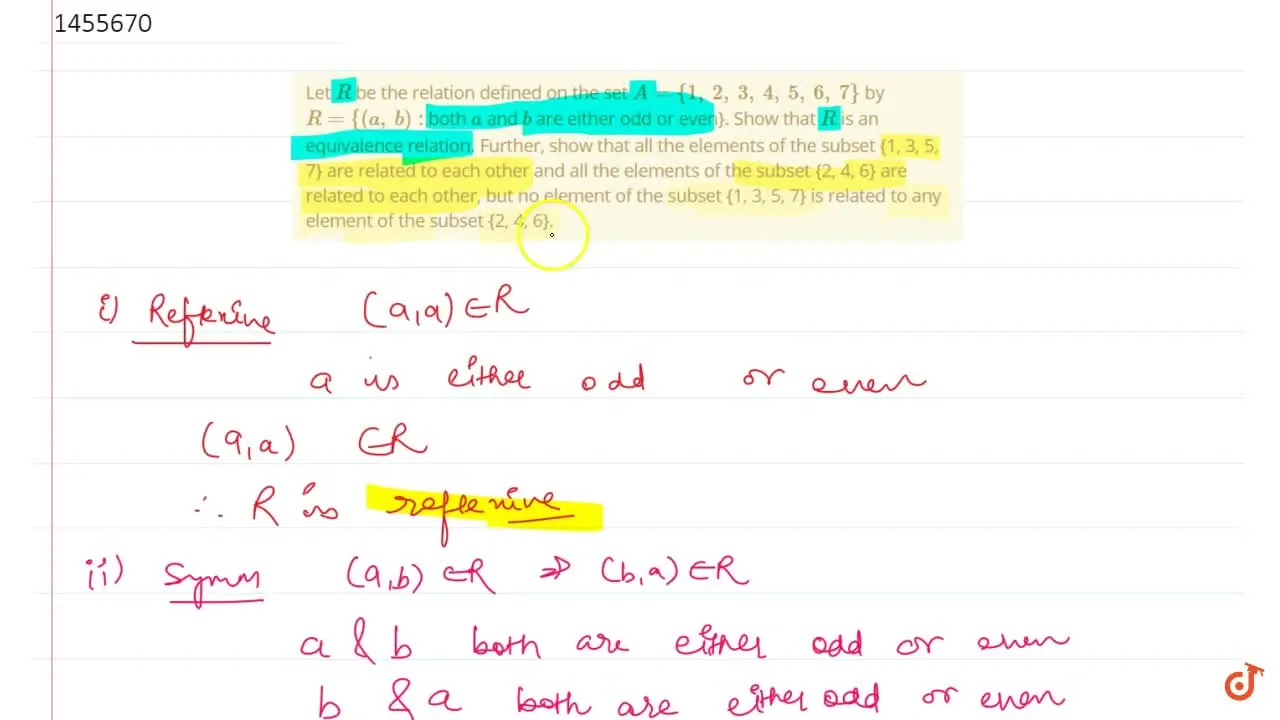Let R be the relation defined on the set A={1, 2, 3, 4, 5, 6, 7} by R={(a, b): both a and b are either odd or even}. Show that R is an equivalence relation. Further, show that all the elements of the subset {1, 3, 5, 7} are related to each other and all the elements of the subset {2, 4, 6} are related to each other, but no element of the subset {1, 3, 5, 7} is related to any element of the subset {2, 4, 6}.
Given A={1,2,3,4,5,6,7}
and R={(a,b): botha and b are either odd or even number}
Therefore,
R={(1,1),(1,3),(1,5),(1,7),(3,3),(3,5),(3,7),(5,5),(5,7),(7,7),(7,5),(7,3),(5,3),(7,1),
(5,1),(3,1),(2,2),(2,4),(2,6),(4,4),(4,6),(6,6),(6,4),(6,2),(4,2)}
To prove that relation is equivalence, we need to prove that it is reflexive, symmetric and transitive.
Reflexivity :
For Reflexivity, we need to prove that- (a,a)∈R
Here (1,1),(2,2),(3,3),(4,4),(5,5),(6,6),(7,7)all∈R
From the relation R it is seen that R is reflexive.
Symmetric:
For Symmetric, we need to prove that- If (a,b)∈R,
then (b,a)∈R From the relation R, it is seen that Ris symmetric.
Transitive:
For Transitivity, we need to prove that- If (a,b)∈R and (b,c)∈R,
then (a,c)∈R[I(a,b) are odd and (b,c) are odd then (a,c) are also odd numbers]
From the relation R, it is seen that R is transitive too.
Also, from the relation R, it is seen that {1,3,5,7} are related with each other only and {2,4,6} are related with each other .
Related Playlists
- BOOK - NCERTCHAPTER - RELATIONS AND FUNCTIONSEXERCISE - EXERCISE 1.413videos
RELATIONS AND FUNCTIONS
- BOOK - NCERTCHAPTER - RELATIONS AND FUNCTIONSEXERCISE - EXERCISE 1.212videos
RELATIONS AND FUNCTIONS
- BOOK - NCERTCHAPTER - RELATIONS AND FUNCTIONSEXERCISE - EXERCISE 1.314videos
RELATIONS AND FUNCTIONS
- BOOK - NCERTCHAPTER - PROBABILITYEXERCISE - EXERCISE 13.218videos
PROBABILITY
- BOOK - NCERTCHAPTER - SETSEXERCISE - EXERCISE 1.31videos
SETS
Similar Questions
Show that the relation R on the set A={1, 2, 3, 4, 5} , given by R={a b|a−b∣ is even }, is an equivalence relation. Show that all the elements of {1, 3, 5} are related to each other and all the elements of {2, 4} are related to each other. But, no element of {1, 3, 5} is related to any element of {2, 4}.
View SolutionCheck whether the relation R defined on the set A={1, 2, 3, 4, 5, 6} as R={(a, b):b=a+1} is reflexive, symmetric or transitive.
View SolutionProve that the relation R in the set A={1,2,3,4,5,6,7} given by R={ab|a−b∣iseven} is an equivalence relation.
View SolutionIs the relation R in the set A={1,2,3,4,5} defined as
R={(a,b):b=a+1} reflexive ?View SolutionCheck whether the relation R defined in the set {1,2,3,4,5,6}as R={(a,b):b=a+1}is reflexive, symmetric or transitive.
View SolutionShow that the relation R in the set A={1,2,3,4,5,6,7}given by R={(a,b):|a−b| is even}, is an equivalence relation.
View SolutionLet R be the relation on set A={x:x∈Z,0≤x≤10} given by R={(a,b):(a−b)is divisible by 4}. Show that R is an equivalence relation.
Also, write all elements related to 4.View SolutionThe relation R in the set A = {1,2,3,4,5} is given by R = {(a,b) : |a - b| is even} is a/an
View SolutionLet R be the relation in the set A={1,2,3,4} given by R={ab|a−b∣ is odd number } Write all the elements of R.
View SolutionLet A = {3,5}, B = {7,1}.
Let R = {(a,b): a∈A,b∈B,a−b is even}.
Show that R is an universal relation from A to B.View Solution


